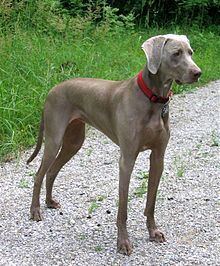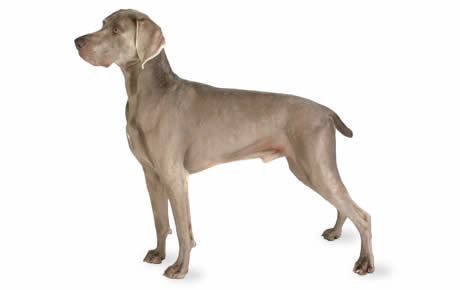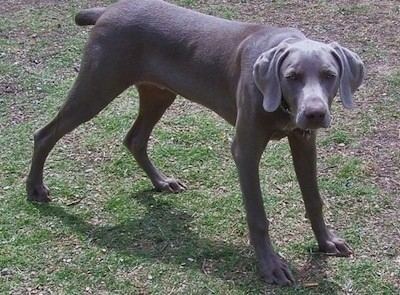Other names Weimaraner Vorstehhund AKC Sporting ANKC Group 3 (Gun dogs) Origin Germany | Common nicknames WeimGrey Ghost Sporting standard Life span 10 – 12 years | |
 | ||
FCI Group 7, Section 1.1 Continental Pointing Dogs: Pointer type #99 Temperament Stubborn, Intelligent, Energetic, Aloof, Alert, Steady, Fast, Powerful Colors Mouse-gray, Silver, Silver-gray Weight Female: 25–35 kg, Male: 30–40 kg Height Female: 59–63 cm, Male: 62–67 cm Similar Vizsla, German Shorthaired Pointer, Rhodesian Ridgeback, Pointer, Great Dane | ||
Weimaraner facts
The Weimaraner (/ˈvaɪmərɑːnər/ VY-mə-rah-nər) is a large dog that was originally bred for hunting in the early 19th century. Early Weimaraners were used by royalty for hunting large game such as boar, bear, and deer. As the popularity of large game hunting began to decline, Weimaraners were used for hunting smaller animals like fowl, rabbits, and foxes.
Contents
- Weimaraner facts
- History
- Appearance
- Coat and color
- Size
- Temperament
- As a hunting dog
- Behavior disorders
- Health
- References

The Weimaraner is an all-purpose gun dog. The name comes from the Grand Duke of Saxe-Weimar-Eisenach, Karl August, whose court, based in the city of Weimar (now in the state of Thuringia in modern-day Germany), enjoyed hunting.

History

Today's breed standards are alleged to have developed in the late 18th and early 19th centuries. However, Chien-gris dogs, having very similar features to the Weimaraner, have been traced as far back as 13th century in the court of Louis IX of France, during which most aristocrats owned one and used them for hunting. One theory is that the ancestor is the St. Hubert Hound (also known as the Bloodhound and Sleuth Hound). Though these dogs are black, they can produce a grey dog when bred. Like the Vizsla at the time, the breed was created exclusively for the nobility. The aim was to create a noble-looking, reliable gun dog. With its restricted ownership and natural instinct, the breed was highly prized and lived with the family. This was unusual since during this period hunting dogs were kept in kennels in packs. This has resulted in a dog that needs to be near humans and that quickly deteriorates when kenneled. The Weimaraner was an all-purpose family dog, capable of guarding the home, hunting with the family, and of course, being loving and loyal towards children.

Originally, Germany was possessive of its skilled all-purpose gun dog. Some of the earliest Weimaraners, prior to being sent to America for breeding, were sterilized in order for America not to popularize their special breed. But starting in the late 19th century the breed became increasingly common throughout Europe and the United States. Although slower than many other gun dogs, such as pointers, the Weimaraner is thorough, which made it a welcome addition to the sportsman's household. The breed's happy, lively temperament has endeared it to families. With the rise in popularity, some changes have been made to the breed. Both in Britain and America (where the breed remains popular) breeders have taken care to breed to a standard.
Appearance

The Weimaraner is athletic in appearance. Traditionally, the tail is docked. In countries where this is still carried out, the docked tail should measure approximately 6 inches in the adult dog, and this is part of the American Kennel Club breed standard. Tail docking is illegal in several countries, where the breed is shown with an entire tail. The British Kennel Club breed standard describes a tail reaching to the hocks and carried below the level of the back when relaxed, and the German breed club standard calls for a full tail that is strong and well coated, which can be carried above the line of the back when the dog is working. Weimaraners are great water dogs as evidenced by their webbed paws.
The eyes of the Weimaraner may be light amber, grey, or blue-grey.
Coat and color
This breed's short coat and unusual eyes give it a distinctive regal appearance. The coat is extremely low-maintenance, short, hard, and smooth to the touch, and may range from charcoal-blue to mouse-grey to silver-grey or even blue-gray. Where the fur is thin or non-existent, inside the ears or on the lips, for example, the skin should be pinkish rather than white or black. This breed does not have an undercoat, so extreme cold should be avoided. While their coat is short, this breed does shed. The Weimaraner's coat color led to its nickname of "the Grey Ghost".
In November 2009 and January 1, 2010, the United Kennel Club (UKC) removed the disqualification from both Blue and Longhair Weimaraners. A black coat remains an automatic disqualification, though a small white marking in the chest area only is permitted. Dogs with blue coats are disqualified from conformation/show competition, but are recognized as purebred Weimaraners by the AKC. There is another incidental variety, described as having the "mark of the hound", where the dog is the usual grey colour but with faint tan markings (similar to Doberman). Weimaraners can have several unique physical characteristics such as small lobes on the inside of the ear, known as "Harrasburg Horns", and "Grafmar's Caps", very light gray patches between the ears.
A long-haired variety is recognized by most kennel clubs around the world except the American Kennel Club. The long-haired Weimaraner has a silky coat, with an undocked, feathered tail. The gene is recessive, so breeding will produce some long-haired puppies only if both parents carry the trait.
Size
According to the AKC standard, the male Weimaraner stands between 25 to 27 in (64 to 69 cm) at the withers.
Females are between 23 to 25 in (58 to 64 cm). Of course, there are many dogs taller or shorter than the breed standard. The breed is not heavy for its height, and males normally weigh about 70–80 lb (32–36 kg). Females are generally between 55–70 lb (25–32 kg). A Weimaraner should give the appearance of a muscular, athletic dog.
Temperament
The Weimaraner is an energetic hunting dog, prized for its physical endurance and stamina, with a strong, instinctive prey-drive. It may tolerate cats but usually does not, tending to follow the urge to hunt—no matter how long it has known a particular cat—and likely to chase and kill any small animal that enters the garden. A Weimaraner requires frequent exercise and will appreciate games and play. An active owner is more likely to provide the vigorous exercise and games required. A Weimaraner requires appropriate training to learn how to be calm and control its behavior.
As a hunting dog
Weimaraners have an excessive amount of energy that requires a good outlet. Weimaraners are well-rounded hunting dogs that excel at hunting, tracking, pointing, and retrieving both on land and in the water. The Weimaraner is a very people-oriented breed. They have a very strong desire to work and live with their owners, making the breed a good choice for the novice hunter. It requires a gentle touch when training to hunt, and it often learns best from a seasoned hunting dog.
Behavior disorders
Weimaraners are not an independent breed and love to be with their owner, never leaving them alone. This can create very severe separation anxiety in the breed. The causes of separation anxiety are not always known but there are precluding factors including, genetics, litter rearing, dominance, submission, boredom, and stress. Weimaraners with severe separation anxiety can destroy property or injure themselves in trying to escape. Good training can curb some of the separation anxiety. A Weimaraner with separation anxiety is likely to bark, whine, howl, and even dig until its owner returns home. Further manifestations of this problem can include panicking, and excessive drooling, along with destructive behaviors and injury.
Health
According to the Orthopedic Foundation for Animals, Weimaraners enjoy low rates of dysplasia. The breed is ranked 102nd of 153 total breeds and has a very high test rate and a very high percentage of excellent rating among those dogs tested. It is generally recommended to acquire Weimaraners only from breeders who have their dogs' hips tested using OFA or PennHIP methods.
As a deep-chested dog, the Weimaraner is prone to bloat or gastric torsion, a very serious condition that can cause painful and rapid death when left untreated. It occurs when the stomach twists itself, thereby pinching off blood vessels and the routes of food traveling in or out. Symptoms include signs of general distress, discomfort, no bowel movement or sounds, and a swollen stomach. Immediate medical attention is imperative when bloat occurs and surgery is the only option if it is caught early enough.
One way to help prevent bloat is to spread out the Weimaraner's feedings to at least twice daily and to avoid any vigorous exercise an hour before or after meals. It is also recommended that the dog's feeding dish not be placed on a raised platform to discourage it from gobbling its food too quickly and keep air from entering the stomach. Raised food bowls have been found to more than double the risk of bloat in large dogs.
Skin allergies can affect some dogs. Take your dog to the vet if it starts to lose hair, itch constantly or develop rashes. You should also check for parasites, as they can cause an allergic reaction in addition to the normal irritation resulting from bites.
Other health issues include:
